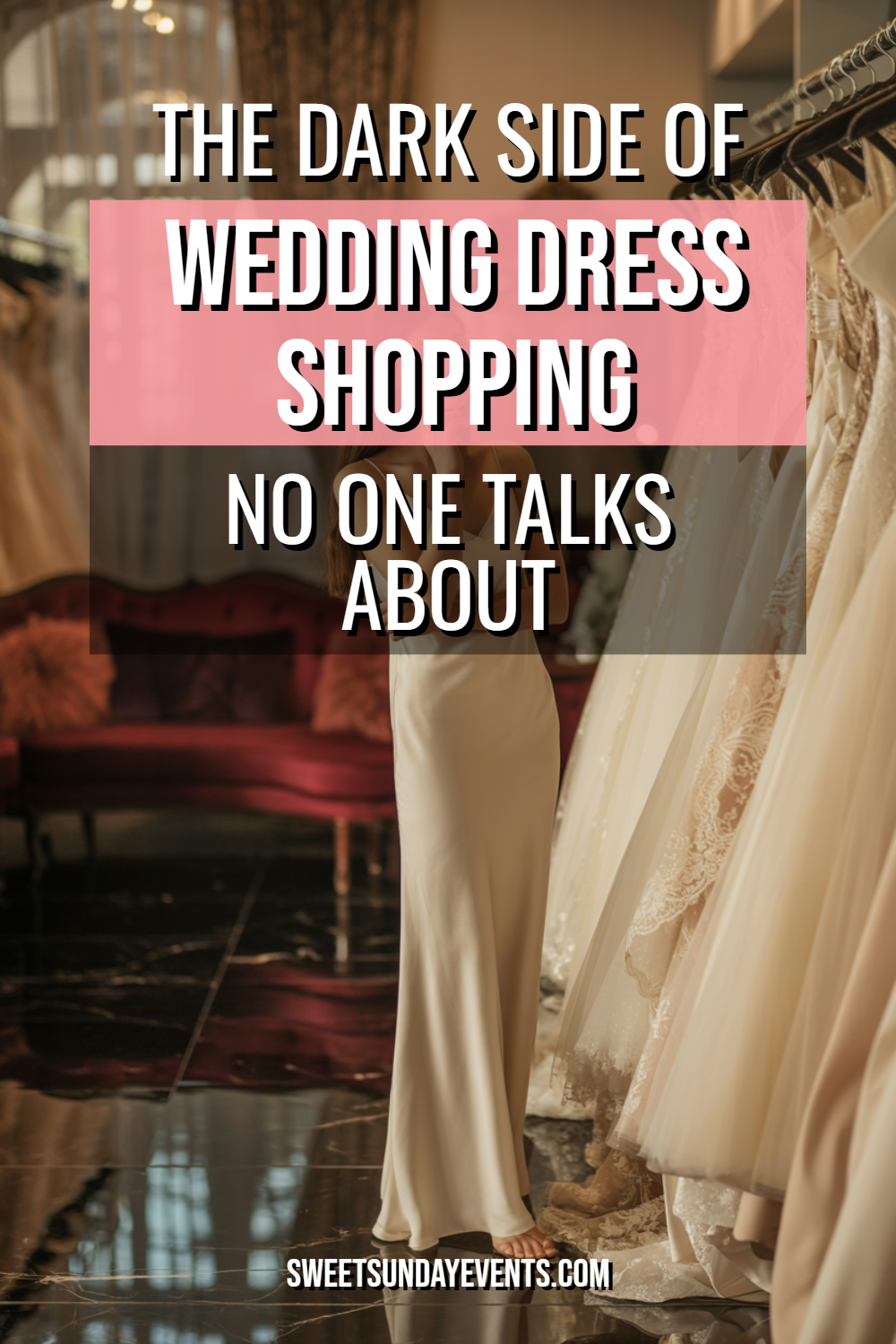Everyone gushes about the magical moment of finding “the one”—that perfect dress that makes you cry happy tears while your entourage applauds.
But behind those Instagram-worthy fitting room photos lies a reality that’s messier, more stressful, and infinitely more complicated than anyone admits.
Let’s talk about what really happens when you step into that bridal salon.
The Appointment Anxiety Nobody Mentions
Booking that first appointment feels like crossing a threshold into official bride territory. But what follows is often a cocktail of panic, pressure, and overwhelming choices that can leave even the most decisive women paralyzed.
Most brides walk into their first appointment with Pinterest boards full of contradictory styles and zero understanding of what actually works on their body.
The sales associate asks what you’re looking for, and suddenly you’re stammering about “something romantic but not too princess-y” while secretly wondering if you even deserve to be there.
The Timeline Trap
Bridal salons love to remind you that dresses take months to arrive, alterations take weeks, and you’re already behind schedule.
This manufactured urgency creates a pressure cooker environment where you’re expected to make a thousand-dollar decision in a two-hour window.
The truth? Most timelines are padded with buffer time, but they’ll never tell you that. Instead, you’ll find yourself agreeing to rush fees and expedited shipping because the thought of being dress-less keeps you awake at night.
When Your Vision Doesn’t Match Reality
That dreamy A-line you’ve been obsessing over might look completely wrong on your body, and that strapless number you swore you’d never wear could be your perfect match.
This disconnect between fantasy and reality can feel like a personal failure rather than a normal part of the process.
Suddenly you’re questioning everything—your taste, your body, maybe even your entire wedding vision. The fitting room becomes a place of reckoning rather than revelation.
The Money Talk That Makes Everyone Uncomfortable
Wedding dress shopping involves more financial anxiety than anyone prepares you for. You walk in knowing your budget, but that number starts feeling either impossibly small or recklessly large the moment you see the price tags.
Salespeople have a talent for showing you dresses “just slightly” over budget—and by slightly, they mean $500 to $1,000 more than you planned to spend.
They’ll frame it as an investment in your special day, conveniently ignoring that you still need to pay for alterations, undergarments, and accessories.
The Hidden Costs Add Up Fast
The sticker price is just the beginning. Alterations alone can cost anywhere from $200 to $800, depending on how much work your dress needs. Then there’s the special bra, the petticoat, the bustle, and suddenly you’re looking at hundreds more dollars.
| Hidden Wedding Dress Costs | Typical Price Range |
|---|---|
| Basic alterations | $200-$500 |
| Complex alterations | $500-$800+ |
| Special undergarments | $50-$200 |
| Steaming/pressing | $75-$150 |
| Bustle installation | $75-$150 |
| Rush fees | $100-$300 |
Nobody warns you about the garment bag fee, the preservation cost if you want to keep the dress, or the fact that you might need multiple fittings at $50 a pop.
When Loved Ones Have Opinions About Your Spending
Bringing family or friends means inviting commentary about your budget choices. Someone will inevitably gasp at the prices, make jokes about down payments on cars, or worse—offer unsolicited advice about spending less on a dress you’ll only wear once.
These comments, however well-intentioned, can make you feel defensive about choices that were already stressing you out. You end up managing other people’s shock while trying to navigate your own financial anxiety.
The Entourage Drama
Movies make it look like bringing your closest people is pure joy, but group dynamics in high-stress situations can get ugly fast.
Everyone has opinions, and somehow your dress choice becomes a referendum on their taste, their relationship with you, and their vision of who you should be.
Your mother might push for something more traditional while your best friend advocates for something sexier.
Your future mother-in-law might make passive-aggressive comments about modesty, and your sister might suggest you’re trying too hard to be someone you’re not.
When Too Many Voices Drown Out Your Own
The cacophony of opinions can make it impossible to hear your own instincts. You start second-guessing reactions that felt genuine and wondering if you’re being swayed by the loudest voice in the room rather than your own preferences.
Some brides find themselves choosing dresses to avoid conflict rather than because they love them. Others shut down completely, unable to process feedback that ranges from enthusiastic to critical to completely contradictory.
The Pressure to Perform Emotion
There’s an expectation that you’ll have a cinematic moment of tears and certainty when you find your dress. But what if you don’t? What if you feel good in a dress but not transcendent? What if you’re more practical than emotional about the whole thing?
The pressure to perform the “Say Yes to the Dress” moment can make you feel broken if your reaction is more subdued. Salespeople and entourage members might keep pushing for that magical feeling, making you wonder if something’s wrong with you or the dress.
Body Image Battles in Harsh Lighting
Bridal salons have a special talent for lighting that shows every perceived flaw while you’re wearing what amounts to a very expensive, very fitted costume. The three-way mirrors don’t lie, but they don’t exactly flatter either.
Many brides find themselves critiquing their bodies more harshly than they have in years. The dress becomes secondary to a litany of self-criticism about arms, backs, stomachs, and everything else that’s suddenly on display.
The Alteration Anxiety
Fittings can become exercises in body dysmorphia as seamstresses pin and tuck while discussing your measurements in clinical detail. You might find yourself obsessing over quarter-inches and asymmetries you never noticed before.
The pressure to lose weight before the wedding often intensifies during dress shopping. Suddenly you’re buying a dress in a smaller size “for motivation” or agonizing over whether your body will change between now and the wedding day.
When Standard Sizing Doesn’t Work
Bridal sizing runs notoriously small and inconsistent across designers. A bride who typically wears a size 8 might need a 12 in wedding dresses, which can trigger all sorts of emotional responses about numbers that shouldn’t matter but somehow do.
Plus-size brides often face limited options and higher costs, while petite brides might find themselves overwhelmed by fabric and trains designed for taller frames.
The industry’s one-size-fits-most mentality can make dress shopping feel exclusionary rather than celebratory.
The Decision Paralysis
With hundreds of styles, dozens of designers, and endless customization options, the sheer volume of choices can be paralyzing.
You might find yourself unable to decide between dresses you genuinely love, or worse—unable to love any dress because you’re constantly wondering if something better exists.
Social media makes this worse by providing endless inspiration and comparison points. You’ll see dresses on Instagram that look perfect but cost three times your budget, or find yourself second-guessing choices based on what strangers are wearing online.
The Fear of Regret
Wedding dress shopping involves making a major purchase months before you’ll actually use the item. This gap creates plenty of time for second-guessing, especially when you see other dresses or when your wedding vision evolves.
Many brides experience buyer’s remorse after saying yes, wondering if they settled or made an impulsive decision. The finality of the purchase—most wedding dresses can’t be returned—adds weight to every choice.
Sample Sale Stress and Trunk Show Chaos
Sample sales and trunk shows promise designer dresses at discount prices, but the reality often involves crowds of competitive brides, limited sizes, and high-pressure sales tactics.
You might find yourself fighting over dresses or making snap decisions based on scarcity rather than genuine preference.
The “buy it now or lose it forever” mentality at these events can override careful consideration. You’re encouraged to purchase immediately, often in sizes that don’t fit, with no guarantee of how alterations will work out.
When the Dream Dress Isn’t Available
Finding your perfect dress only to discover it’s discontinued, out of budget, or not available in your size creates a unique kind of heartbreak. You might spend months trying to find something similar or settling for your second choice while mourning the one that got away.
Custom recreations and knockoffs rarely capture what made the original special, leaving you with a dress that’s almost right but not quite perfect.
The Aftermath Nobody Prepares You For
Even after you’ve chosen your dress, the anxiety doesn’t end. You’ll worry about damage, weight fluctuations, and whether you made the right choice every time you see another bride’s photos.
The dress hangs in your closet like a expensive reminder of all the decisions still to come.
Final fittings bring their own stress as you realize this is really happening and the dress you chose months ago needs to be perfect for the most photographed day of your life.
Finding Your Way Through the Chaos
Despite all these challenges, most brides do find dresses they love and feel beautiful wearing. The key is acknowledging that the process might be harder than expected and giving yourself permission to feel whatever comes up.
Set boundaries with your entourage, trust your instincts over outside opinions, and remember that the perfect dress is the one that makes you feel like yourself on your wedding day. Everything else is just noise.


